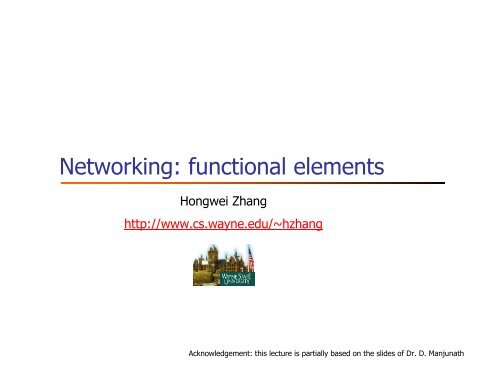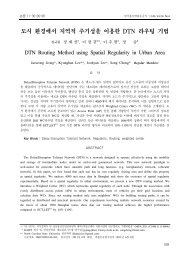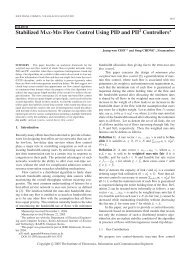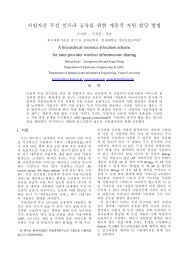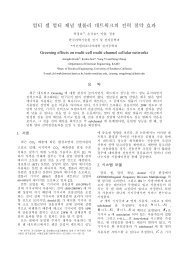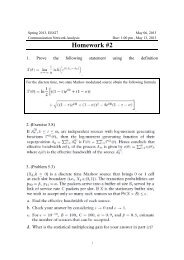Networking: functional elements - Network Systems Laboratory
Networking: functional elements - Network Systems Laboratory
Networking: functional elements - Network Systems Laboratory
You also want an ePaper? Increase the reach of your titles
YUMPU automatically turns print PDFs into web optimized ePapers that Google loves.
<strong><strong>Network</strong>ing</strong>: <strong>functional</strong> <strong>elements</strong><br />
Hongwei Zhang<br />
http://www.cs.wayne.edu/~hzhang<br />
Acknowledgement: this lecture is partially based on the slides of Dr. D. Manjunath
Outline<br />
<strong><strong>Network</strong>ing</strong> as resource sharing<br />
Functional <strong>elements</strong><br />
Multiplexing<br />
Switching<br />
Routing<br />
<strong>Network</strong> management<br />
Traffic controls and timescales
Outline<br />
<strong><strong>Network</strong>ing</strong> as resource sharing<br />
Functional <strong>elements</strong><br />
Multiplexing<br />
Switching<br />
Routing<br />
<strong>Network</strong> management<br />
Traffic controls and timescales
<strong><strong>Network</strong>ing</strong><br />
Information technology is as much about manipulating<br />
information as about moving or transporting information<br />
<strong><strong>Network</strong>ing</strong> deals with Information Transport. More<br />
specifically, the mechanisms that govern the sharing of<br />
the resources in the bit carrier infrastructure.
Preliminaries<br />
Points at which networked information services connect to generators<br />
and absorbers of information flow, called sources and sinks<br />
respectively<br />
Example sources: telephone transmitters, video cameras, file on a disk<br />
Example sinks: telephone receivers, video monitors, storage devices<br />
source/sink<br />
source/sink<br />
source/sink<br />
Distributed<br />
information applications<br />
source/sink<br />
source/sink<br />
source/sink
A layered view<br />
sources and/or sinks<br />
networked applications<br />
Information services<br />
<strong><strong>Network</strong>ing</strong><br />
Communication links<br />
Bit Carrier Infrastructure<br />
A three-layered view of a communication network. “<strong><strong>Network</strong>ing</strong>” is concerned with resource<br />
sharing mechanisms that efficiently share the bit carrier infrastructure, and control the quality<br />
of service provided to the various applications using the network<br />
Common Information Services<br />
User interfaces, transducers, servers,<br />
browsers, source compression, storage,<br />
buffering, jitter removal, etc.<br />
Resource Sharing Mechanisms<br />
Dynamic and intelligent control of<br />
infrastructure and traffic flow :<br />
Multiplexing, scheduling, routing,<br />
network management<br />
WDM, Optical crossconnects, SDH, DSL,<br />
cable, Ethernet, satellite, fixed or mobile<br />
wireless links
A layered view (contd.)<br />
A layered view helps in identifying and distinguishing<br />
different classes of functions<br />
Similar to the concept of subroutines or functions in<br />
programming<br />
Three layers<br />
Information Services Layer<br />
Bit Carrier Infrastructure Layer<br />
“<strong><strong>Network</strong>ing</strong>” Layer
Information services<br />
Hardware and software to facilitate the transport service<br />
and attach the source and sink<br />
Encode information from source into a transportable form and<br />
decode received information into usable form<br />
Examples<br />
Voice coding, packet buffering and playout, and voice decoding for<br />
packet telephony<br />
Mail preparation and forwarding software for electronic mail
Information services (contd.)<br />
Handle network induced imperfections—loss, delay,<br />
delay variations<br />
Define the allowable imperfections from the network—Quality of<br />
Service (QoS) as statistical (mean, percentiles) or deterministic<br />
(bounds) guarantees<br />
Example QoS measures: service denial (blocking), delay, delay<br />
variations, loss, reordering, etc.
Bit carrier infrastructure<br />
The raw material for building the information transport<br />
superstructure<br />
The issues here are those from a classical communication<br />
course—modulation, capacity, channel coding, medium<br />
characteristics, etc.<br />
Reasonable to assume that the channel is digital<br />
We assume that the communication links are imperfect bit pipes<br />
in the sense that these pipes can delay, lose or modify the bits<br />
that they carry
<strong><strong>Network</strong>ing</strong><br />
Uses the raw material of communication links and<br />
provides the networking services that the information<br />
services assumes<br />
The link design problem is concerned with the bit flow—extract<br />
the maximum bit rate possible, <strong><strong>Network</strong>ing</strong> is concerned with<br />
information flow
Computer OS analogy<br />
Distributed<br />
information<br />
applications<br />
(e.g., www, e-commerce, teleconf)<br />
Distributed<br />
algorithms for<br />
information transport<br />
(e.g., X.25, Internet, ATM)<br />
<strong>Network</strong> of<br />
communication links<br />
<strong><strong>Network</strong>ing</strong> is concerned with distributed algorithms for efficient sharing of bit<br />
carrier network resources. Very similar to OS of a computer helping applications to<br />
use and share hardware resources<br />
Applications<br />
(e.g., calculation, accounting,<br />
database)<br />
Computer<br />
operating system<br />
(e.g., Unix, Linux, Windows)<br />
Hardware<br />
(e.g., processor, memory,<br />
disk drives, sound card)
Outline<br />
<strong><strong>Network</strong>ing</strong> as resource sharing<br />
Functional <strong>elements</strong><br />
Multiplexing<br />
Switching<br />
Routing<br />
<strong>Network</strong> management<br />
Traffic controls and timescales
Functional <strong>elements</strong>:<br />
consider a sample information flow<br />
After source prepares the bits for transportation, “network” decides<br />
how to route flow over physical network<br />
Infrastructure is shared by many such flows. Hence network has to<br />
decide how to multiplex this flow with other flows.<br />
Flow may traverse multiple links. At junction of two links, switch<br />
flow <strong>elements</strong> to target link.<br />
Need to monitor network behavior and collect status information;<br />
possibly handle situations for which network is not engineered. i.e.,<br />
perform network management.
Outline<br />
<strong><strong>Network</strong>ing</strong> as resource sharing<br />
Functional <strong>elements</strong><br />
Multiplexing<br />
Switching<br />
Routing<br />
<strong>Network</strong> management<br />
Traffic controls and timescales
Multiplexing<br />
Communications links or bit pipes are expensive resources and<br />
possibly imperfect;<br />
Need to amortize cost among a large number of sources — need<br />
mechanism to share efficiently<br />
Assume information flow requirements — source and destination and<br />
capacity required — is a time varying process<br />
Sharing the communication link is multiplexing — technique used for<br />
systematically merging several data flows into one bit-pipe.<br />
Two types of multiplexing:<br />
Circuit multiplexing<br />
Packet multiplexing
Circuit multiplexing on a link<br />
Link capacity is statically partitioned into channels (possibly different<br />
capacities)—Frequency, Time, Space and Code Division Multiplexing<br />
Standards specify partitioning details, e.g., CCITT and North American<br />
standards for TDM<br />
Each conversation (flow) is allocated to a channel for the entire<br />
duration of call—the call holds the channel<br />
Connection setup is required to allocate resources<br />
Fixed rate allocated at time of connection setup determines the peak<br />
rate at which the source can transmit data<br />
A call (request for resources) can be blocked if all the channels are busy
Circuit multiplexing (contd.)<br />
Performance measures:<br />
Connection setup delay<br />
Call blocking probability<br />
A typical design problem:<br />
What should be the link capacity for a given load and specified blocking<br />
probability?<br />
The link may also have to handle different classes of flows each with<br />
a different blocking probability requirement
Circuit multiplexing: resource allocation<br />
model<br />
link<br />
time<br />
Static partitioning of bandwidth in a circuit switched network<br />
channels
Inefficiency of circuit multiplexing?<br />
Most sources generate data in bursts:<br />
Voice: Talk and silence spurts<br />
Video: Scene changes<br />
Telnet: Typing behaviour<br />
Web browsing patterns: Think times between downloads
it rate<br />
Motivating packet multiplexing<br />
random epochs of data emission<br />
talk spurt silence<br />
scene<br />
change<br />
video frames (e.g., 30 frames/sec)<br />
Traffic flow from sources is typically bursty<br />
Average rate is much lower than peak rate<br />
Capacity is wasted during “lean periods”<br />
data emitted by a computer<br />
PCM (pulse coded modulation)<br />
voice with activity detection<br />
variable-bit-rate video
Packet multiplexing<br />
link<br />
No partitioning of the bit pipe<br />
time<br />
packets from various connections<br />
Apply entire bit rate to a source and hence, each packet gets the entire bit pipe for shorter<br />
periods of time<br />
Packets will need to contain header and trailer information to identify with a specific<br />
information flow (source, destination, application, etc.)
Packet multiplexing (contd.)<br />
Source peak rate can exceed link rate<br />
Packets may need to be queued;<br />
If buffer capacity is not sufficient, packets may be dropped and<br />
hence lost<br />
Abstraction:<br />
Link is a server serving customers waiting in a queue<br />
Performance measures:<br />
Packet delay<br />
loss characteristics
Centralized packet multiplexing<br />
Terminal<br />
Terminal<br />
Terminal<br />
Terminal<br />
multiplexer ports<br />
Multiplexer Multiplexer<br />
full-duplex link<br />
Centralized packet multiplexing: multiplexers have full control over link’s<br />
transmission rate<br />
Multiplexer stuffs packets on to link; has complete control over link<br />
Scheduler can decide sequence of transmissions<br />
Host<br />
Host
Distributed packet multiplexing<br />
Distributed packet multiplexing: sources share link in a distributed fashion<br />
Sources (hosts/nodes) connected to a multipoint link (wiretap, wireless<br />
channel).<br />
link<br />
Nodes
Distributed packet multiplexing (contd.)<br />
Only one source can successfully transmit on the channel<br />
at any time—multiple access channel<br />
Design Issue: Coordination among the sources<br />
Random access: collision recognition and resolution<br />
Controlled access: various flavors of polling — central or<br />
distributed
Polling based multiplexing<br />
Token ring<br />
Node
Reservation based multiplexing<br />
A Satellite System Example: very small aperture terminal (VSAT) <strong>Network</strong><br />
Packet<br />
switch<br />
Inbound channel to the hub is shared<br />
Propagation delay is large, no instantaneous feedback of result of the<br />
transmission — cannot use polling or contention based random access<br />
VSAT<br />
DIU<br />
VSAT<br />
DIU<br />
Router<br />
Router<br />
Campus<br />
network<br />
Campus<br />
network
VSAT network (contd.)<br />
Ask for reservations from the hub using some contention<br />
mechanism<br />
Successful reservations and the frame structures are<br />
communicated on the outbound channel to the users
Multiplexing summary<br />
multiplexing<br />
circuit multiplexed packet multiplexed<br />
centralized distributed<br />
random<br />
access<br />
master-slave<br />
polled<br />
access<br />
reservation<br />
access<br />
token passing
Hybrid multiplexing<br />
circuitmultiplexed<br />
packetmultiplexed<br />
Combining circuit multiplexing and packet multiplexing on a link; Partition<br />
capacity into circuit & packet multiplexing parts<br />
Important example: “2B+D” ISDN services<br />
More complex solutions vary boundary; rarely implemented<br />
movable<br />
boundary
Outline<br />
<strong><strong>Network</strong>ing</strong> as resource sharing<br />
Functional <strong>elements</strong><br />
Multiplexing<br />
Switching<br />
Routing<br />
<strong>Network</strong> management<br />
Traffic controls and timescales
Switching: motivation<br />
(a)<br />
A six node network constructed in three ways—(a) A brute force way.<br />
(b) Every node is connected to a central switch that selectively<br />
establishes paths between nodes and (c) Hierarchical network with inter-<br />
switch links with possibly multiplexing on it.<br />
S 1<br />
(c)<br />
S 2<br />
S<br />
(b)
Switching<br />
link<br />
Information flow will traverse more than one link.<br />
Switch is required at junction of two or more links.<br />
Switch is a device that selectively establishes and releases connections<br />
between communication links to allow sharing of these links among a<br />
number of flows (connections).<br />
Switch<br />
link<br />
link
Switching (contd.)<br />
Switch moves information from link to link by<br />
demultiplexing on the inbound link and multiplexing on<br />
the selected outbound link.<br />
A switch is required with circuit multiplexing and<br />
centralised packet multiplexing
Functions of a switch<br />
Two categories, also called planes of functions—data plane and<br />
control plane<br />
Data plane functions<br />
Demultiplex the flow (e.g., packet or time slot) on the input link<br />
Switch the flow element onto the appropriate output link<br />
Multiplex the flows on the output link<br />
This implies every packet or slot in a TDM frame needs to be processed<br />
Thus these are fast timescale functions: performed per packet or per<br />
frame<br />
Specialized hardware may be used for these high speed functions
Functions of a switch<br />
Control plane functions<br />
Connection setup and resource allocation/reservation<br />
Achieved through source-network and switch-switch signaling<br />
Functions performed over connection (flow) arrival timescales<br />
General purpose processors can be used; Increasing interest in<br />
parallelization<br />
Routing and local conditions information dissemination<br />
Usually performed at timescales at which traffic characteristics change
Design issues in a packet switch<br />
Control and signaling functions include<br />
populating the routing table<br />
participating in distributed algorithms associated, for example, with routing<br />
Datagram packet switches:<br />
every packet of a flow is treated independent of previous packets in the flow:<br />
queueing, address lookup, packet classification, etc.<br />
Virtual circuit packets switches:<br />
Connection setup to allocate path and resources on links on path to the flow<br />
Packets are assigned link level labels, and switched based on labels<br />
Performance measures: switching delay in getting to the output queue, packet<br />
loss rate
Design issues (contd.)<br />
Input and output lines could be slotted or unslotted<br />
Correspondingly, packets lengths and interarrival time have<br />
discrete or continuous distributions<br />
Packet lengths could be fixed or variable
Components of a packet switch<br />
Line<br />
interface<br />
Line<br />
interface<br />
Input processing<br />
and forwarding<br />
Input processing<br />
and forwarding<br />
Control and signaling functions<br />
Queueing and<br />
scheduling<br />
Queueing and<br />
scheduling<br />
Switch<br />
fabric<br />
O/p Queue<br />
scheduling,<br />
processing<br />
O/p queue<br />
scheduling,<br />
processing<br />
Line<br />
interface<br />
Line<br />
interface
Call setup in a circuit switch<br />
Detect off hook, apply dial tone, accept digits, perform digit analysis<br />
From routing algorithm determine next switch on path to destination<br />
and perform signaling to reserve channel on link to the switch<br />
If path is available reserve resources and “program” the pair “output<br />
port:TDM slot” for the channel on the incoming port of the call<br />
Maintain call<br />
Release resources on completing the call and perform possible<br />
billing functions
Call setup (contd.)<br />
phone goes off hook<br />
apply dial tone<br />
dial digits<br />
call accept (or deny) signal<br />
call complete signal (on hook)<br />
calling phone switch<br />
dial tone delay<br />
call-processing delay<br />
information transfer<br />
call teardown delay
Functions of a circuit switch<br />
Switching functions such as<br />
setting up circuit inside switch between input and output and maintain it<br />
for duration of call<br />
Call processing functions such as<br />
off-hook detection<br />
digit acceptance and analysis<br />
routing call and corresponding signaling for path reservation and billing<br />
functions<br />
Background functions for executing protocols for routing,<br />
management and maintenance of the switch
Circuit Switch: Logical View<br />
input i<br />
TDM frame<br />
x<br />
Control processor<br />
TDM frame<br />
y<br />
output o
Operation of a circuit switch<br />
Each slot on each input line contains the information flow unit for a<br />
circuit<br />
At the time of circuit set up, the switching pattern—output port and<br />
the slot in the output port, is determined<br />
The fabric will perform the switching operation which is repeated in<br />
every frame<br />
In figure, the contents of slot S on input line i are switched to slot S o<br />
on line o
Outline<br />
<strong><strong>Network</strong>ing</strong> as resource sharing<br />
Functional <strong>elements</strong><br />
Multiplexing<br />
Switching<br />
Routing<br />
<strong>Network</strong> management<br />
Traffic controls and timescales
Routing<br />
A route is an ordered sequence of links between a source and a<br />
destination<br />
A network node, or a switch, performs the routing function along<br />
with multiplexing and switching;<br />
Nonetheless, routing is a “network wide” function and the nodes<br />
collaborate in making routing decisions
Routing (contd.)<br />
Often, routing and forwarding are used synonymously and this is<br />
wrong!<br />
An incoming packet is processed, its output port determined and then<br />
the packet is forwarded to the output link. Thus forwarding is a fast<br />
timescale operation and is a data plane function, meaning it operates on<br />
the data.<br />
The decision of which output port this packet should be sent is made on<br />
slower timescale. This depends on the route that the packet will take in<br />
the network. Thus this is a control plane activity.<br />
The forwarding function consults a routing table to decide the output<br />
port for a packet. The routing function populates this routing table
Routing: computation models<br />
Objective of routing algorithm: use network resources<br />
efficiently<br />
Conflicts of providing QoS to customers and utilizing network<br />
resources efficiently needs to be addressed<br />
<strong>Network</strong> topology information and user requirements<br />
need to be known<br />
Routing decisions can be centralized or distributed
Routing: computation models (contd.)<br />
In centralized routing the network topology information is collected<br />
using a distributed algorithm at a central node where the routes are<br />
determined for every possible source-destination pair. These routing<br />
decisions communicated to all the nodes in the network<br />
In distributed routing, distributed algorithms are used to collect<br />
topology information and make routing decisions<br />
Information aggregation may be used to minimize “information<br />
explosion”<br />
An obvious solution is use of hierarchies.
Distributed routing<br />
Decision Models<br />
Source Routing: The decision on the sequence of the links to the<br />
destination may be made at the source<br />
The routing information is embedded into the packet and is used by<br />
the intermediate nodes in the network to forward the packet<br />
appropriately<br />
Hop-by-Hop Routing: Each node only knows the ‘next node on<br />
the best route’ to the destination<br />
The nodes need not know the entire route to the destinations
Tasks in routing<br />
Exchange of local topology information with neighbors at faster<br />
timescales<br />
This helps keep track of link status and also the demands on the links.<br />
The latter helps in determining QoS capabilities of the routes.<br />
Perform any aggregation that may be required by the algorithms<br />
and disseminate aggregated information.<br />
A Routing Protocol will be used to exchange information that is<br />
necessary for the routing algorithm
Tasks in routing (contd.)<br />
Route computations are based on the topology<br />
information collected and use a routing algorithm.<br />
Topology information exchange always occurs. Route<br />
computation may be triggered and/or time driven.<br />
Granularity of route computation<br />
Fine grained on demand routing on a per session basis<br />
Coarse grained per flow routing where fat pipes are a priori set<br />
up
Design and performance issues<br />
Routing protocols:<br />
What information to exchange, how often, how to exchange<br />
Routing Algorithms:<br />
Objective functions for best effort routing and QoS routing<br />
Emerging scenarios<br />
Multicast routing algorithms<br />
Routing protocols and algorithms for rapidly changing topologies,<br />
e.g., ad hoc networks
Design and performance issues (contd.)<br />
Performance measures:<br />
Connection blocking probability, load imposed on the network,<br />
adaptation to changes in the network conditions.<br />
Connection blocking only relevant in connection based networks.<br />
Typically associated with circuit multiplexed networks.<br />
In datagram networks, connections are not set up. Hence no concept of<br />
connection blocking.<br />
Virtual circuit based networks use packet multiplexing but set up a<br />
connection before data transfer begins to alert the switches of the creation<br />
of a flow
Outline<br />
<strong><strong>Network</strong>ing</strong> as resource sharing<br />
Functional <strong>elements</strong><br />
Multiplexing<br />
Switching<br />
Routing<br />
<strong>Network</strong> management<br />
Traffic controls and timescales
<strong>Network</strong> management<br />
Handle conditions for which the network is not engineered<br />
Different from ‘congestion control’ where the overload conditions are<br />
short lived.<br />
All operational networks define a management architecture to<br />
collect and control the network resources.<br />
Performance data are collected by managed network devices these<br />
are in turn are gathered by a network management station in the<br />
network that will analyze the data that has been collected.
<strong>Network</strong> management (contd.)<br />
The management architecture provides some control<br />
functions that can be performed on remote managed<br />
devices by management stations either in a programmed<br />
manner or through an operator<br />
Security issues are also handled by a network<br />
management architecture.
Outline<br />
<strong><strong>Network</strong>ing</strong> as resource sharing<br />
Functional <strong>elements</strong><br />
Multiplexing<br />
Switching<br />
Routing<br />
<strong>Network</strong> management<br />
Traffic controls and timescales
Traffic controls and timescales<br />
<strong>Network</strong> functions cover a wide variety of timescales—of<br />
the order of a few microseconds to minutes to months<br />
and years. Rather than consider absolute time we<br />
identify the following four relative timescales:<br />
Packet timescale (packet transmission time; seconds or<br />
milliseconds)<br />
Session, call or flow timescale (typically minutes)<br />
Busy hour or traffic variation timescale (typically hours)<br />
Provisioning timescale (usually hours to days or weeks)
Traffic controls and timescales (contd.)<br />
Packet timescale controls discriminate between treatment of<br />
individual packets (e.g., transmission scheduling, buffer allocation)<br />
Accepting and the routing of a call in connection oriented networks<br />
are made on slower timescales, and in the order of session<br />
interarrival times<br />
Since traffic processes vary over a day/week and probably have<br />
some cyclical patterns, resource allocation algorithms and thresholds<br />
may need to change at the rate at which traffic processes in the<br />
network change.<br />
Resource provisioning occurs over longer periods, e.g., from months<br />
to years


